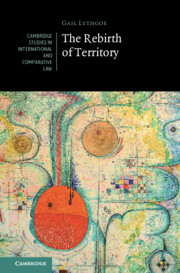Refine search
Actions for selected content:
65 results
Chapter 7 - Seeing and Not-Seeing, Saying and Not Saying, “God”
- from Part III - A Program for a Positive Jewish Theology
-
- Book:
- Reviving Jewish Theology
- Published online:
- 20 November 2025
- Print publication:
- 04 December 2025, pp 171-192
-
- Chapter
- Export citation
Chapter 14 - The Land of Many Laws
- from Part III - Exits
-
-
- Book:
- Colonialism and the EU Legal Order
- Published online:
- 14 October 2025
- Print publication:
- 18 September 2025, pp 314-342
-
- Chapter
-
- You have access
- Open access
- HTML
- Export citation
‘Difference’ and ‘Similarity’ in Comparative Law: Lessons from Process-Relational Philosophy
-
- Journal:
- Canadian Journal of Law & Jurisprudence , First View
- Published online by Cambridge University Press:
- 27 August 2025, pp. 1-39
-
- Article
-
- You have access
- Open access
- HTML
- Export citation
10 - The Powers of the President and the Executive Branch in a Period of Ferment
-
- Book:
- The Changing Constitution
- Published online:
- 21 August 2025
- Print publication:
- 21 August 2025, pp 268-294
-
- Chapter
- Export citation
3 - From “Final Solution” to “Holocaust”: Autobiographical Reflections
-
-
- Book:
- The Cambridge History of the Holocaust
- Published online:
- 16 May 2025
- Print publication:
- 12 June 2025, pp 62-73
-
- Chapter
- Export citation
I - The Cats of Queen Berúthiel
-
- Book:
- Tolkien and the Mystery of Literary Creation
- Published online:
- 17 April 2025
- Print publication:
- 08 May 2025, pp 22-83
-
- Chapter
- Export citation
16 - Examining Elephants in the Dark
- from Part III - Conclusion
-
-
- Book:
- Ways of Seeing International Organisations
- Published online:
- 17 April 2025
- Print publication:
- 24 April 2025, pp 311-322
-
- Chapter
-
- You have access
- Open access
- HTML
- Export citation
1 - Seeing International Organizations Differently
- from Part I - Thinking International Organisations Differently
-
-
- Book:
- Ways of Seeing International Organisations
- Published online:
- 17 April 2025
- Print publication:
- 24 April 2025, pp 3-15
-
- Chapter
-
- You have access
- Open access
- HTML
- Export citation
24 - What Is Thought and What Makes It Free? Or, How I Learnt to Stop Worrying and Love the Forum Externum
- from Part VI - The Right to Freedom of Thought in Context
-
-
- Book:
- The Cambridge Handbook of the Right to Freedom of Thought
- Published online:
- 06 March 2025
- Print publication:
- 13 March 2025, pp 305-320
-
- Chapter
- Export citation
The Function of Hypocrisy Norms
-
- Article
-
- You have access
- Open access
- HTML
- Export citation
Searching for homophony avoidance in English coronal stop deletion
-
- Article
-
- You have access
- Open access
- HTML
- Export citation
2 - We Are All Staying Put
-
- Book:
- Radically Legal
- Published online:
- 06 June 2024
- Print publication:
- 06 June 2024, pp 11-40
-
- Chapter
-
- You have access
- Open access
- HTML
- Export citation
Beyond the machinery metaphors: Towards a theory of international organizations as machines
-
- Journal:
- Leiden Journal of International Law / Volume 37 / Issue 3 / September 2024
- Published online by Cambridge University Press:
- 03 May 2024, pp. 608-629
-
- Article
-
- You have access
- Open access
- HTML
- Export citation
1 - Introduction
-
- Book:
- The Rebirth of Territory
- Published online:
- 07 March 2024
- Print publication:
- 14 March 2024, pp 1-29
-
- Chapter
- Export citation
2 - Deterritorialisation Discourse in International Law
-
- Book:
- The Rebirth of Territory
- Published online:
- 07 March 2024
- Print publication:
- 14 March 2024, pp 30-70
-
- Chapter
- Export citation

The Rebirth of Territory
-
- Published online:
- 07 March 2024
- Print publication:
- 14 March 2024
2 - The Consensus on Corruption
- from Part I - Laying the Groundwork
-
- Book:
- Rethinking Corruption
- Published online:
- 27 February 2024
- Print publication:
- 22 February 2024, pp 16-31
-
- Chapter
- Export citation
Servitised property and personality: theorising servitisation through the personality theory of property
-
- Journal:
- European Law Open / Volume 2 / Issue 4 / December 2023
- Published online by Cambridge University Press:
- 02 February 2024, pp. 833-856
-
- Article
-
- You have access
- Open access
- HTML
- Export citation
33 - Comparing Regional Law
- from Part IV - Comparative Law beyond the State
-
-
- Book:
- The Cambridge Handbook of Comparative Law
- Published online:
- 26 January 2024
- Print publication:
- 01 February 2024, pp 649-673
-
- Chapter
- Export citation
2 - Traditional Methods
- from Part I - Methods of Comparative Law
-
-
- Book:
- The Cambridge Handbook of Comparative Law
- Published online:
- 26 January 2024
- Print publication:
- 01 February 2024, pp 15-31
-
- Chapter
- Export citation
